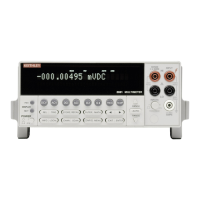IEEE-488 Reference
4-200
If the queue becomes full, the message “350, ‘Queue Overflow’” will occupy the last memory
location in the register. On power-up, the queue is empty. When the Error Queue is empty, the
message “0, ‘No error’” is placed in the Error Queue.
The messages in the queue are preceded by a number. Negative (-) numbers are used for SCPI
defined messages, and positive (+) numbers are used for Keithley defined messages. Table 3-4
lists the messages.
After this command is sent and the Model 2001 is addressed to talk, the “oldest” message in the
queue is sent to the computer.
NOTE: The :SYSTem:ERRor? query command performs the same function as the
:STATus:QUEue? query command (see STATus subsystem).
Programming example 10 DIM A$ [30]
20 OUTPUT 716; “:syst:err?”
30 ENTER 716; A$
40 PRINT A$
50 END
Line 10 Increases string size to accommodate message.
Line 20 Reads the Error Queue.
Line 30 Addresses the Model 2001 to talk.
Line 40 Displays the message from the Error Queue.
4.22.6 :AZERo commands
:TYPE <name>
:SYSTem:AZERo:TYPE <name> Specify auto-zero type
Parameters <name> = NORMal Auto-zero every 200msec
= SYNChronous Auto-zero for every reading
Format :syst:azer:type <name>
Defaults Power-up Saved power-on setup
*RST NORMal
:SYSTem:PRESet NORMal
Query :TYPE? Query auto-zero type
Short-form format: :syst:azer:type?
Response message: NORM or SYNC
Description The :AZERo commands are used to control the auto-zero phase of each measurement. During a
normal reading conversion, the input signal is compared against a measured reference signal and
a measured zero signal to ensure an accurate measurement. When auto-zero is disabled, the zero
signal measurement is not performed, allowing the reading rate to be increased. However,
accuracy is compromised. The longer auto-zero is disabled, the more inaccurate the readings
become.

